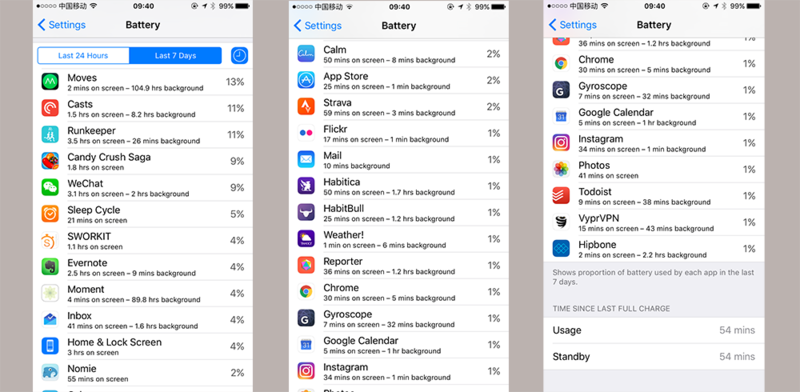
How much do you use your phone? Which apps do you spend the most time on? Are you addicted to Candy Crush or some other game? How often are you checking your email? Just what are you doing on your phone?
These are some of the questions we all want to answer about our phone usage. Unfortunately, Apple devices can make this a bit of a pain.
While an iPhone is an amazing device for tracking steps and loads of other health data, Apple’s permissions have historically made it hard to track the overall phone usage. Unlike an Android, you don’t have access to a lot of underlying activity on your phone. Fortunately, there is an easy workaround for any self-tracker looking to know more about their mobile usage.
Hidden in your iPhone preferences is section called “Battery” and it contains a lot of interesting information. Technically it’s recording how certain apps consume your battery. But with the click of a setting, you can suddenly see all of your iPhone usage data as an amount of time. You can even know your actual screentime on these individual apps.
In this post, we will how you how to find this area and some simple techniques to log your usage as well as how you might use this data for self-improvement.
How to Get Your Basic iPhone Usage Stats
Personally, I believe that one of the most important things we can do in our lives is be aware of what we are doing. For me this means self-tracking and in particular understanding my time. Since I work on the computer a lot of my time is computing time and RescueTime is perfect tool. Unfortunately no such tool exists (or can exist) on iPhone.
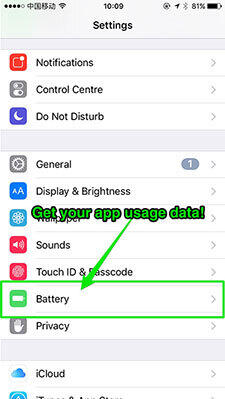
Fortunately, there are a couple approaches to tracking your phone usage.
If you use an Android Phone, I recommend installing and setting up RescueTime. RescueTime is background tracker that passively tracks your usage. I use it continuously to track my computer usage time.
There are also a number of iPhone apps that make clever usage of your phone’s GPS to record when you open and close your phone and then, in turn, create an overall usage log. Moment is a good example of this.
Since iOS 9, Apple iPhones and iPads added a section that exposes your overall battery usage and breaks it down app-by-app.
To get to this section, you go to Settings and open up the area called “Battery.” This section has two settings: one for putting your phone in low power mode and another for showing battery percentage in the status bar.
Below those settings is your battery usage. This is shows you the battery usage of your apps in percentage. If you click the “clock” icon you’ll get the usage time of that icon on screen and in the background. Furthermore you can get this data for the last 24 hours and the last 7 days:
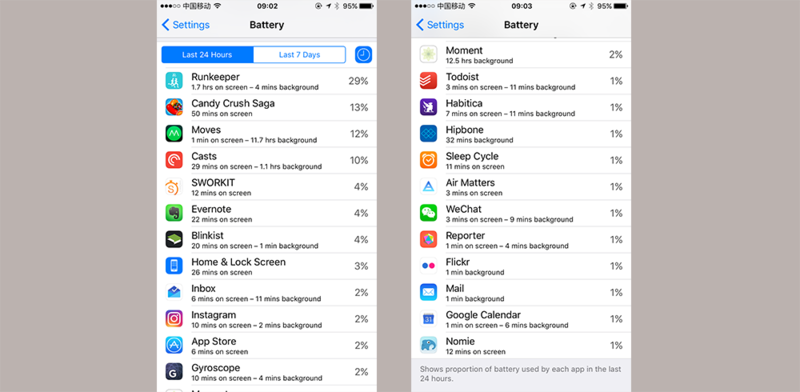
You’ve got data!
Recording and Storing Your iPhone Usage
Personally, I think it’s important to consider how and how much we use certain technologies. RescueTime has been my favorite tool to help me refine how I use my computer time to do productive and meaningful work. By looking at the numbers and setting up processes and notifications, I was able to work less on my computer while getting the same or greater output of work.
There is no automatic way to export your iPhone usage data. At the time of writing, your best option is taking screenshots.
Each week I do a weekly review. It’s quite useful for self-development and overall personal organization. I track a lot of data points, and considering how much we use our phones, I have started to include my iPhone usage too.
So, each week I take a couple of screenshots of my usage data via the Battery Usage setting page and add it to my weekly report. Recently I’ve also been logging this data to a spreadsheet in order to look at my iPhone usage data over time. Like most self-trackers, a good percentage of my self-tracking analysis eventually happens through spreadsheets.
This allows me to create simple charts of my usage by category:
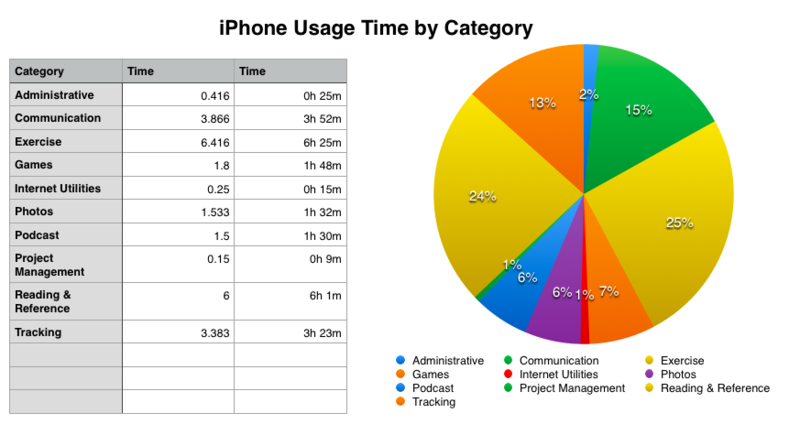
Alternatively, Moments app appears to be the easiest method for capturing this data. Moments also does this by taking a screenshot each day or week. It goes one step further by parsing this data and importing it. Furthermore you can export this data as a JSON file.
Depending your use case, I find collecting these screenshots and manually recording a few data points to serve my needs.
Conclusion: Know Your Time
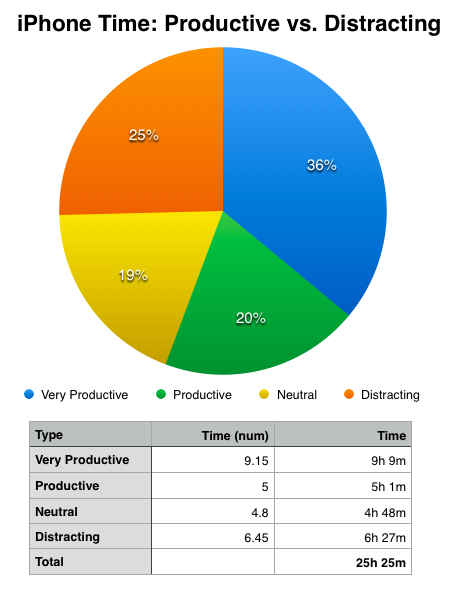
It’s impossible to deny how interconnected our lives are with our smart devices. Like the phantom limb syndrome, we feel something missing without our smart phones.
But just how well do we understand our smart phone usage? Are we aware of how we spend our lives on these devices?
We use our phones for a lot more than calls. In fact, it’s likely you spend very little of your phone time making calls.
If you are keen to track more of your life or, as we are, to track everything, then it’s crucial to track your phone usage. Fortunately there is a nifty workaround on iOS to capture your usage data.
Fortunately, recent versions of iPhone’s operating system makes it easy to see your app usage. By peaking into your battery usage, you can can see your overall app usage. Whether you are curious about what’s burning up your battery time or want to know more about your actual app usage, this section provides a lot of interesting data.
For me this allows me to get to couple of useful data points on individual apps and app categories. Using some simple logic I can even calculate my productive score. But for me it comes down to one number: total screentime.
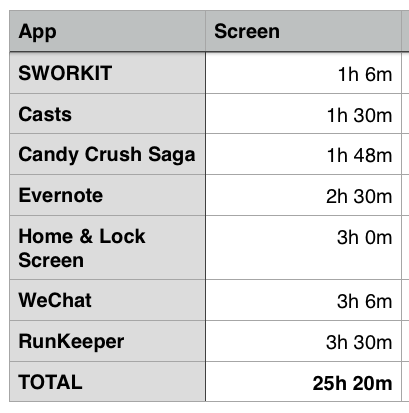
By looking at which apps I spend the most screentime on and my overall usage numbers I can start to quantify my mobile phone life. As an obsessive self-tracker, I’m happy to have found more data points to log and learn from simply by checking out my battery usage statistics.
We work and live more and more via our mobile phones. We use our phones less and less for traditional calls. Increasingly we use our phones for a lot of other forms of communication from SMS to chat apps. We also use our devices for consuming, reading, gaming and thousands of other small and large ways.
Sadly or not, we live on our phones. Our smarts phones are an extension of our brains and an extension of our social lives.
My phone is a mixed device. I use it for work and for play. I also use it to relax and distract. As such, it can be a device to empower me or to distract me. By looking at the data on my phone usage, I’ve become more aware of what I’m doing.
Like tracking steps in order to get more active or food tracking to eat better, time tracking is area that uses tracking as a step towards transformation. First you track and see what you do. Then you consider which things you want to do less or more of. And then you attempt to implement ways to make it happen.
Time tracking is crucial for personal understanding and development. If you can master your time and the usage of your time, there is no limit to what you can achieve. Hopefully by looking at my iPhone usage data regularly we gain another layer of self and time mastery through technology.
Good luck and happy tracking.
